Millions of home and business owners rely on furnaces to keep interiors warm.
However, a surprisingly large number of them do not fully understand the filter’s purpose and value.
With this comprehensive guide, you’ll learn an abundance of information about furnace filters, including the best type to buy, where to find the lowest prices, how to install and maintain them, how long furnace filters last and much more.

What's in this Guide?
- Here is a List of the 7 Best Furnace Filters
- Furnace Filters Buying Guide
- How Furnaces Work
- Why Filters Are Critical for Both Home and Business Furnaces
- Types of Furnace Filters
- Tips for Choosing the Best Filters
- Where to Buy Quality Filters at an Affordable Price
- Furnace Filter Ratings
- The Effects of a Clogged Filter
- Key Benefits of a New Filter Installation
- Answers to Frequently Asked Questions
Here is a List of the 7 Best Furnace Filters
1. AIRx Health
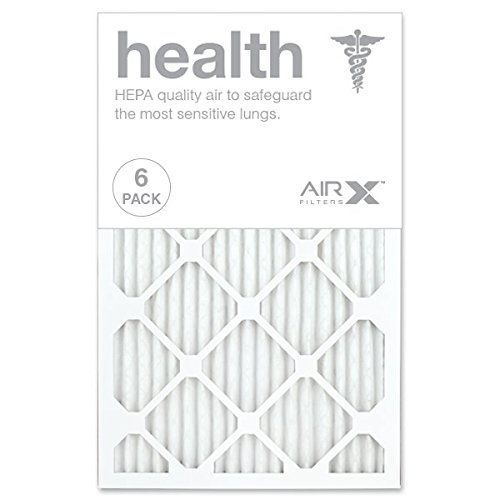
Our Review: As a HEPA filter, this is perfect for people with breathing sensitivities. Installing an AIRx Health filter will make a dramatic difference in the air pushed out by your air-conditioning and heating unit. The filter traps smog, bacteria, dust, debris, mold, viruses, and various other respiratory irritants. It even captures extremely small particles that can negatively affect a person’s health.
With the correct MERV rating and a pleated design, this furnace filter improves the efficiency of your HVAC system. As a result, it enhances airflow, reduces energy consumption, and lowers maintenance costs.
Key Features:
- Electrostatic air media traps respiratory irritants, bacteria, viruses, smog
- High efficiency filter
- Made in U.S.A
2. FilterBuy
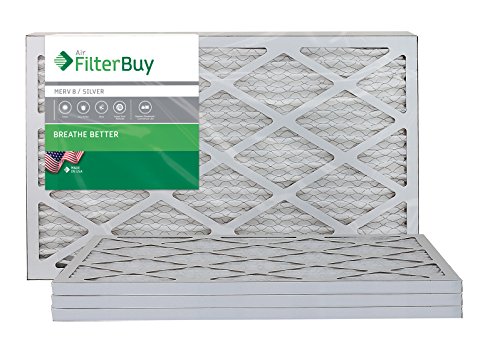
Our Review: FilberBuy has several different types of well-made furnace filters. It has an electrostatically charged design capable of attracting and trapping larger allergens. This product is ideal for high-velocity HVAC systems, and it lasts up to three months. Compared to washable, non-electrostatic, and fiberglass pleated 1-inch filters, this one excels.
There’s also the Odor Eliminator with activated carbon that removes foul smells from the air associated with cooking, inside animals, and smoke. The 12-pleat per foot design traps 90 percent of all airborne particles, including pollen, pet dander, lint, debris, and dust. This filter can even withstand exposure to dampness and moisture.
Key Features:
- Traps 90% of airborne particles
- Ideal for residential and commercial use
- Made in U.S.A
3. Filtrete Micro Allergen
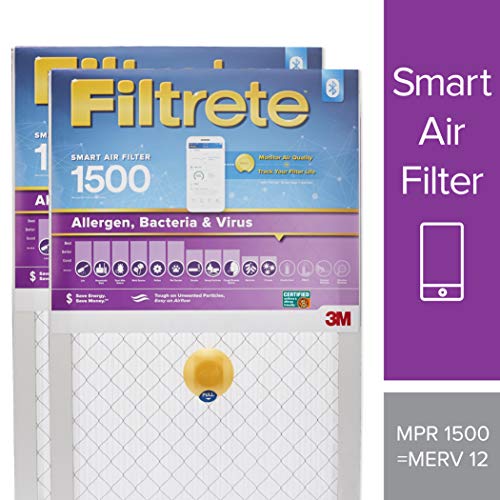
Our Review: Sold in both 4- and 5-inch sizes, this deep-pleated filter has some unique qualities. For one thing, the Filtrete Micro Allergen filter can trap air particles as small as 0.3 microns. It also has an electrostatic technology that reduces the most common types of household allergies such as dust, lint, mold spores, pet dander, pollen, smog, and dust mite debris.
Additionally, it boasts the 3-in-1 technology from 3M, which allows the filter to draw in and trap irritants while simultaneously pushing clean air into the atmosphere. Another advantage is this furnace filter lasts between 6 and 12 months depending on your heating system and the degree of trapped particles.
Key Features:
- First Ever Bluetooth-enabled HVAC air filter
- Smart air filter detect changes in air pressure, calculate filter life
- Smart App available for IOS and Android devices
4. Honeywell Air Filter
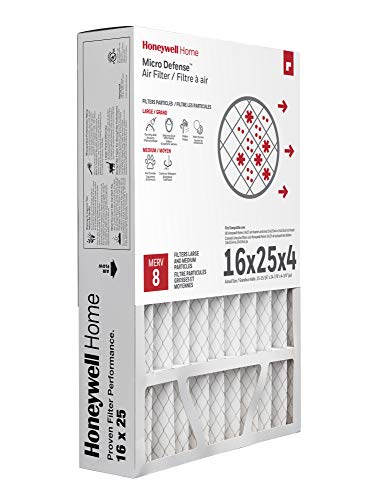
Our Review: As with the other brands, Honeywell has an impressive product lineup. Its Elite Allergen pleated furnace filter ranks among the best. This product has the highest FPR available, and it comes in multiple sizes to fit almost all heating units. For trapping various types of allergens, this filter is a top choice.
Key Features:
- Lasts up to 12 months
- Easy to install
- Merv 8 rating
5. Lennox X6673
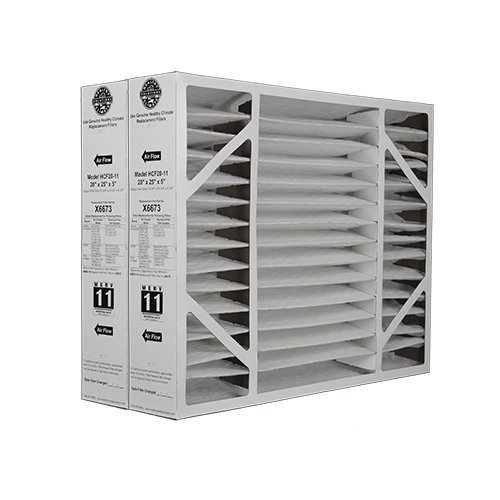
Our Review: Lennox has a long history of making superior quality furnace filters, including this product. As a BMAC electrostatically charged filter, it captures contaminants down to 0.3 microns, and when full, you simply throw it away. In addition, this filter will typically last six months. Made with a synthetic media, this Honeywell filter has a large surface that is perfect for blocking particles while offering little air resistance.
Key Features:
- MERV 11
- Comes in 2 pack
- Only filter that fits the Lennox
6. Nordic Pure
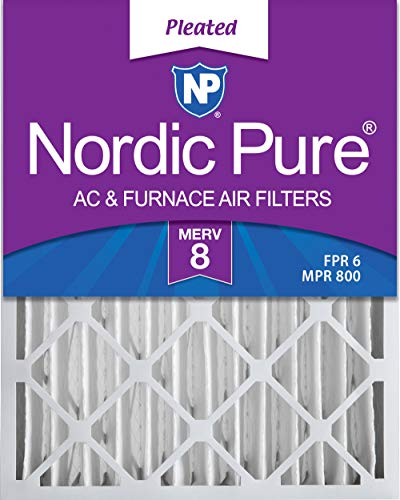
Our Review: Offering different sizes, types, MERV ratings, and even mini-pleats, Nordic Pure has incredible choices. This company can even customize a furnace filter for your specific heating unit. An example of its product line is the Pure Carbon, which neutralizes unpleasant odors. This filter works so well; it’s a perfect choice for homes, as well as manufacturing companies, chemical plants, and other industrial sites.
Key Features:
- Electrostatic filter, captures dust, mold spores, pollen
- Hypoallergenic and antimicrobial filter material
- Made is the U.S.A.
7. Trophy Air Filter Washable
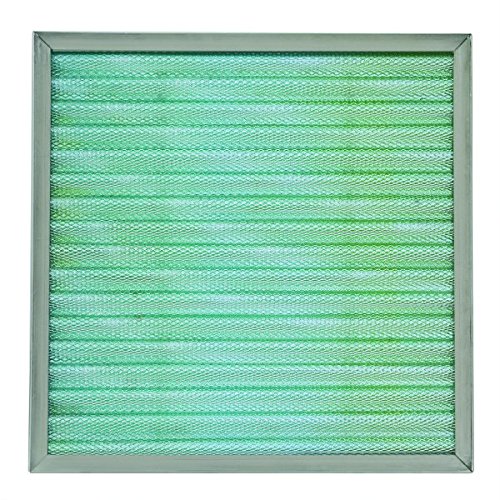
Our Review: If you prefer something reusable, check out the Trophy Air washable filter. Not only can you wash it, but the design offers enhanced heating and cooling effectiveness. You can expect improved and cleaner airflow thanks to its four layers of high-grade aluminum combined with two layers of electrostatic media.
Along with precision craftsmanship, this furnace filter simply slides into your furnace, allowing you to install a replacement in just seconds. This American-made filter offers excellent durability and long-lasting wear.
Key Features:
- Washable
- Premium craftsmanship
- Made in the U.S.A.
Furnace Filters Buying Guide
For some reason, there’s little to no information as to when and who invented the first furnace filter. However, it’s known that in the early 18th century, Englanders first started using combustion air coming from an outside duct to make interior rooms more comfortable. Later that same century, a Scottish man, named James Watt, developed the first working heating system that operated on steam combined with a connection of pipes.
Then in 1883, Thomas Edison invented the first electric heater, followed by the patenting of the first thermostat two years later by Warren Johnson. The big breakthrough came in 1919 when Alice Parker patented the first central heating system, forever changing how people kept their homes and businesses comfortable.
At some point, people began using filters to prevent particles from blowing inside of rooms, especially after the invention of the fan system in the late 1890s. The one fact easily obtained is that the original design of filters was intended to protect the blower motor found in older-style furnaces and the evaporator coil in air-conditioning units.
How Furnaces Work
When it comes to furnaces, you have two options — gas and electric. Regardless of the type of unit you use to heat your home or business, they both require filters. While there are not a lot of differences between them, the furnaces themselves operate in different ways.
Gas Furnaces
A gas furnace is just what the name implies: A unit that relies on gas to force warm air into the interior atmosphere. With this, you set a thermostat to the desired temperature with the furnace running until it reaches that level. In other words, to heat a room to 75 degrees, you would set the thermostat to that number.
In response, the thermostat sends a low-voltage signal to the furnace’s relay. Upon receiving the signal, a valve inside the furnace opens to allow natural gas to reach the burners. At the same time, the blowers begin to operate.
The furnace has either a pilot light or electronic ignition, which lights the burners located within the combustion chamber, causing heat to form in the heat exchanger. The blower pushes air around that metal chamber. As it becomes warm, the blower forces the air into a hot plenum that moves it through the ductwork and into interior rooms.
To ensure safety, the burning fuel created by combustion gases vents through a flue on the roof. However, if you opt for a high-efficiency furnace, the venting process goes through a wall.
Electric Furnaces
Typically, most people prefer a gas furnace over one that runs on electricity. Although an electric unit is more environmentally friendly, the cost to operate it is significantly higher. Especially for people who prefer eco-friendly options, an electric furnace is a viable choice.
An electric model also receives a signal from the thermostat. The difference is that instead of burners, the unit has electric heating elements controlled by circuit breakers. With this option, a blower draws air into the cabinet that contains the breakers via a cold-air return.
From there, the blower forces air through the heat exchanger, where electrically controlled heating elements heat the air. Next, blowers push the warm air through the ductwork and into the interior rooms.
The primary benefit of choosing an electric furnace is that it doesn’t produce carbon monoxide, an odorless but potentially deadly gas. That makes the unit safer not only for humans and pets but also the environment. There’s one additional advantage of an electric furnace. Without combustion gases, there’s no need for a flue. Therefore, the installation process is much easier.
Why Filters Are Critical for Both Home and Business Furnaces
Whether for a residential or commercial furnace, both gas and electric units require filters. These filters prevent dust from blowing through the air and covering furniture, electronics, flooring, countertops, and other surfaces. They also help capture allergens, including pet dander and pollen. In fact, some of the more technologically advanced filters prevent germs from circulating.
Without the proper type and size of filter installed, you could expect a host of unpleasant issues, such as higher energy bills, poor airflow, inadequate heat, a damaged fan, and even an overheated furnace. Also, without the right filter, the furnace works harder, leading to premature failure and a high replacement cost.
Sometimes, people run furnaces without a filter, which is something you want to avoid. Without a filter, dirt and debris would likely become trapped in the blower, causing serious damage to the unit itself. In addition, because the purpose of a filter is to trap contaminants, running a unit without one puts people’s health at risk.
Advances in Furnace Technology
Thanks to technological advances, furnaces today work more efficiently from both a performance and cost perspective. Following are just a few examples of how far furnace designs have come.
Delayed Airflow
Perhaps one of the greatest advances in furnace technology is the blower delay. In older units, both the fans and burners or heating elements turned on simultaneously. That meant cool air pushed into the atmosphere before heated air. Feeling a blast of cold air before the warm air is an unpleasant experience. With this innovative design, warm air blows out immediately.
Variable Speed
Another development is the introduction of the variable-speed furnace. With this model, the fan changes speed as needed. That means the unit runs smoother and without consuming as much energy. This technological change works great for covering both hot and cold spots in various rooms.
Quieter Operation
There’s no denying that older model furnaces make a tremendous amount of noise when operating. If you’ve had your unit for some time, once you replace it with a more modern option, you’ll realize a stark difference.
Remember, an efficient furnace uses less energy, which helps reduce noise. Also, a programmable furnace doesn’t work as hard or run as long to reach the desired temperature — again diminishing annoying sound.
Types of Furnace Filters
There are many different types of furnace filters available. Although they all work in a similar way, some are more beneficial than others. Keep in mind that some manufacturers recommend a specific type of filter. That doesn’t mean you have to buy the suggested product, but that it should be your first consideration.
Disposable Fiberglass
Made from spun glass, disposable fiberglass filters work great for capturing larger-sized particles. You will only use this filter for about 30 days, after which time you’ll throw it away and replace it with a new one. You can purchase a new filter for around $3 from any hardware or home improvement store.
Apart from lasting only 30 days, there are a few additional downsides to this type of filter. Most importantly, if you fail to change it according to the recommended schedule, your furnace loses efficiency. Because these filters clog quickly, your heating system would have to work extra hard to keep your home or business comfortable. Consequently, you use more energy.
Disposal fiberglass filters also do not work very well in trapping small-sized particles. Therefore, they don’t offer the same level of protection as others do. Ultimately, more contaminants filter into rooms, affecting people with allergies and upper respiratory problems.
Electrostatic
Electrostatic filters are made from self-charging paper or cotton fibers that produce a positive charge. They work great for attracting various kinds of impurities in the air, including allergens, dust, and dirt. Many of these filters are permanent. But there’s also a washable type that lasts longer, making it more cost-effective.
Electrostatic filters catch smaller particles, making them perfect for homes with pets, smokers, and young children. While you can find these filters in most standard sizes, the one drawback is they cost significantly more. For instance, depending on whether you select a permanent or disposable design, you’ll likely spend between $20 and $200. If you need a customized size, you’ll pay even more.
Pleated
For pleated furnace filters, you have two options — disposable and high-efficiency. The disposable type filters are a step above disposable fiberglass filters because they work better at trapping smaller particles. They are also inexpensive and readily available. If you want to improve indoor air quality and are not overly sensitive to allergens, dust, and debris, disposable pleated filters are a good choice.
Aside from needing to change disposable pleated furnace filters at least every 30 days, there aren’t any major drawbacks. The key is to switch the filters out at the same time each month to prevent restricted air flow and the heating unit from working overtime.
As for high-efficiency pleated filters, they catch even the smallest particles, which in turn drastically improves indoor air quality. Especially for big families, people with upper respiratory problems, and large work environments, these filters are excellent since they help prevent the spread of illness.
The one thing that people don’t like about high-efficiency pleated furnace filters is the price. In addition, they don’t work in every type of furnace because of their thicker design for removing smaller pollutants. However, if they’ll fit your furnace, it’s worth paying the higher price.
Activated Carbon
Although activated carbon filters are among the older types, they’re still beneficial. These filters have small absorbent pores that react chemically as pollutants pass through. During that process, the pollutants and carbon bond. While the carbon filter absorbs gasses, chemicals, smoke, and even unpleasant odors, the additional filter traps dirt and debris.
Keep in mind that activated carbon filters are seldom used alone. Because these filters do not remove dust or microorganisms, you would need a second type of filter as well. Together, they prevent pollutants from becoming airborne.
HEPA
HEPA, the acronym for “High-Efficiency Particulate Air,” is another excellent option. This technology dates back to the WWII era to remove radioactive dust particles that put soldiers’ lives at risk.
Today, a lot of home and business owners go with HEPA filters because they can trap up to 99.97 percent of all airborne particles as small as 0.3 microns. For microns as tiny as 0.1, these filters have a 95 percent success rate. With those capabilities, many medical professionals recommend HEPA furnace filters to patients with sensitivity to allergens, dust, and debris.
HEPA filters work so well; they also trap pet dander, dust mite debris, mold, pollen, and bacteria. However, these filters can’t capture chemicals, gasses, smoke, and odors, which is why you should also use an activated carbon filter. That way, you have full coverage for all contaminants.
With all these benefits that HEPA filters offer, they can’t trap small viruses. Also, the microorganisms these filters trap can breed or reproduce. Even so, if you want a good, all-around filter for your heating unit, HEPA filters are worth considering.
Electronic Air Cleaners
If you want an extra layer of filtration protection, you should consider using an electronic air cleaner along with the right type of furnace filter. Sold as a separate device, these cleaners remove airborne contaminants using static electricity.
As part of the design, electronic air cleaners have a pre-filter, ionizing wires, and metal collector plate. When air enters the device, it passes through the pre-filter, which works by trapping larger particles. From there, the now cleaner air goes into an ionizing chamber that produces an electric charge to remove any remaining contaminants.
In the final step, air flows into the collector plate, which produces an opposite charge to bring the particles to stick on the plate’s surface. You will benefit the most from an electric air cleaner if you use fiberglass furnace filters. With the added cleaner, this type of filter traps more contaminants.
Most of the best brands on the market today can capture 99.97 percent of particles as tiny as 0.3 microns. That makes them just as efficient as HEPA filters. For the best results, it’s essential that you keep the metal collector plate and pre-filter clean. About once a month, simply run both of these components through the dishwasher.
There is another option for an electronic air cleaner. You can have one professionally installed in your ductwork. One important thing to remember is you need to turn either your heating unit or air conditioner on. Only then would the blower force air through the device. Unlike an electronic cleaner you keep on all day and night, one connected with the ductwork does not work continuously.
Whether you choose a standalone device or one that uses the ductwork, air cleaners do not kill mold spores, viruses, or bacteria. In addition, they cannot trap gasses, including volatile organic compounds associated with household cleaning products, new carpeting, wall paint, and furniture.
Tips for Choosing the Best Filters
Now that you have a much better understanding of the different types of furnace filters available, you need to know how to choose one of superior quality. These tips will make the selection process easier.
Top-Rated Brands
Because furnace filters play such a critical role in keeping indoor air clean, there’s an abundance of excellent brands. However, with so many possibilities, it’s easy to become confused or feel overwhelmed when trying to make the right selection.
Following are some of the brands that the top experts highly recommend. Just remember, there are many additional options available.
- AIRx
- FilterBuy
- Filtrete
- Honeywell
- Lennox
- Nordic Pure
- Trophy Air
For each brand, specific product examples are listed above.
Where to Buy Quality Filters at an Affordable Price
You can purchase top-quality furnace filters from any hardware and home improvement store. They’re also available at discount retail stores like Walmart and Target. However, for the best selection and the lowest prices, you should start by shopping online at Amazon.
If you own a multi-unit apartment complex, serve as the property manager, or handle all the maintenance calls, a Prime membership equates to free shipping. Therefore, you could order as many furnace filters you need without the added expense. There are many other reasons for finding your products on Amazon, including an abundance of options and incredible deals on the top brands.
Manufacturer’s Recommendations
Manufacturers of all the leading furnace filter brands agree that regardless of which one you choose, there are specific things to look for and factors that make one option better than another. For both residential and commercial purposes, focus on the following when buying a new or replacement filter.
Unit Specifications
Start by checking the specifications for your heating unit. Remember, every furnace has a unique design. So, while you might automatically think that a high-efficiency filter is the best choice, it may not be. Also, more commercial furnaces use true HEPA filters today in units to heat homes.
If you have a newly installed furnace, check the documentation it came with. While for an existing unit that you have no paperwork, you can always call the manufacturer. By providing the model and serial number, a representative can tell you exactly the type of filter to purchase.
It’s important to note that using the wrong filter in your furnace could do more harm than good. For one thing, it could reduce the unit’s energy efficiency. Even worse, it could damage the system. For these reasons, make sure you buy the appropriate filter.
Correct Size
It’s just as important that you purchase a furnace filter in the correct size. You need whatever your heating unit calls for, so it will slide in easily and stay firmly in place. You can refer to the documentation provided with a new furnace or simply look at the size of the old filter to see what you need to buy. It there’s no size listed, use a standard measuring tape for the length, width, and thickness.
Tested Rating
There are several different ratings used by manufacturers of furnace filters. The MERV is the most dependable. This particular rating determines the level of efficiency in filtering air particles. A low rating means more contaminants pass through the filter medium while a high rating traps even the smallest particles extremely well.
To achieve the cleanest air quality possible, choose a furnace filter with a high MERV rating or one that ranks at the top of other rating codes. While you might spend slightly more, it’s worth every cent.
Furnace Filter Ratings
Beyond all the other factors involved in choosing the best furnace filter, focus most of your attention on the ratings. For this, there are three primary codes: MERV, FPR, and MRP.
Filter Testing
In simple terms, manufacturers of furnace filters perform testing to assess how well the filters block out or trap air pollutants. The testing process is what determines the filtration effectiveness. Regardless if the filter has an MERV, FPR, or MPR rating, the higher the number, the more effective it is.
MERV
Experts consider the Minimum Efficiency Reporting Value (MERV) rating as the industry standard. This particular rating is the only one rated as a nationally regulated system. The American Society of Heating, Refrigerating, and Air Conditioning developed this rating as a way of identifying a filter’s ability to trap air pollutants and particles.
MERV has a scale of 1 to 20, with 20 as the best. The higher the number, the better the furnace filter is in capturing particles. However, there’s one caveat: A rating above 13 could block airflow and cause backpressure in your system, which in turn, would decrease efficiency. For that reason, you’d want to buy a high MERV-rated filter but only to what your specific furnace can accommodate.
FPR
Filter Performance Rating (FPR) serves as a unified ranking system, yet it lacks figures that make it easy to understand. Along with a number scale ranging between 4 and 10, FPR has a color-coded system used to rate a filter’s ability to trap certain particles and its overall quality. Developed by The Home Depot, you can find FRP filters at any store although they’re also available online through Amazon.
MPR
Created by 3M, the MPR rating, which stands for “Microparticle Performance Rating,” is a trusted source. However, this rating is only used for 3M and Filtrete brand filters, both manufactured by 3M. The lowest 300 MPR is a basic option that works relatively well. But to trap particles as small as 1 micron, you would want a furnace filter with an MPR rating of 2800.
Proper Installation
While some of the larger and more complex heating units used for commercial purposes might require a few additional steps, for the most part, the process is super easy. Usually toward the bottom and off to one side of the heating unit is an open slot. All you have to do is slide the filter inside, making sure it fits snugly.
Maintenance Schedule
As you read over some of the best filters on the market, you saw a variation in when to replace them. When buying a new filter, you’ll see the manufacturer’s recommendation on when to either wash or toss a filter out. Typically, you want to replace lower quality filters every 30 days whereas some of the better products can last up to six months. If you have any question, speak to a store clerk with knowledge or research the schedule online.
The Effects of a Clogged Filter
The last thing you want is for a furnace filter to clog. As you’ll discover, this leads to a host of problems, some quite costly.
Increased Energy Efficiency
For your heating system to operate properly and efficiently, it relies on the constant recirculation of air. If a filter becomes clogged, it forces the blower fan to run longer and harder, which requires more electricity. According to a study performed by the Department of Energy, a clogged furnace filter can increase energy consumption by as much as 15 percent.
Frozen Evaporator Coils
Because the filter works to trap air particles for both your furnace and air-conditioning system, a clog during the hot summer months can cause the evaporator coil to freeze. In that case, there’s a lack of airflow moving over the coil, making it impossible for the condensation to dissipate. As a result, the air conditioner cannot remove heat, which leads to hot air blowing inside the house and the risk of permanent damage to the unit.
Inadequate Cooling and Heating
Another problem that develops as a result of a clogged filter is that the blower has to work incredibly hard to force air through the medium. As airflow diminishes, you can expect to feel either cold or hot spots throughout the home or business place. This also makes it nearly impossible to reach the desired indoor temperature regardless of where you set the thermostat.
Decreased Air Quality
Instead of clean air blowing through the furnace filter, air travels through mounds of dust, debris, and other pollutants. That means rather than healthy air, you and other people breath in contaminated air. Especially for individuals with upper respiratory problems like asthma, COPD, and even allergies, this wreaks havoc on the body.
The other problem is that if you don’t replace the filter in an industrial setting, there’s a risk of people breathing in toxins. What it comes down to is a clogged filter creates an unhealthy environment.
Cracked Heat Exchanger
The heat exchanger is a critical component of your furnace. When a filter clogs, airflow becomes restricted. Because of that, it causes the heat exchanger to overheat, which at some point, leads to cracks.
Furnace Failure
The worst-case scenario associated with a clogged filter is the failure of the heating unit. Not only could the clog lead to premature failure of the furnace but also of the air conditioner. What happens is a clogged filter forces the air blower to work overtime. Once it gives out, you’ll need to purchase an entirely new system. Experts agree the leading cause of equipment failure is a clogged furnace filter.
Dirty Furnace Components
A lot of people never think about what a dirty filter does to the internal components of a furnace. Just as the blower forces pollutants into homes and businesses, it blows dirt and debris on the inside of the unit. Therefore, you could also face problems with various parts and components giving out because of a clogged filter.
Key Benefits of a New Filter Installation
There’s no question that installing a replacement filter according to the recommended schedule provides a ton of benefits.
Reduces Energy Costs
Even with a stabilized economy, you don’t want to spend a dime more than you have to on anything. Instead of setting your thermostat at a ridiculous level, you can enjoy a comfortable home or work environment and still run your furnace. Using the right type and size filter is an excellent way to cut down your energy consumption.
Maintains Healthy Indoor Air Quality
You want to live and work in an environment that is clean and healthy. The best way to accomplish that is by achieving excellent air quality through the timely replacement of a furnace filter. Especially with a filter capable of trapping particles as small as 0.3 microns and one with an odor-absorbing quality, you’ll enjoy a healthy environment and eliminate foul smells.
Cleans Furnace and Air-conditioning Unit
A clogged air filter forces contaminated air into rooms and damages internal components, as well as puts the unit at risk of failure. When you install a new filter, those things are never a concern.
Extends the Life of the HVAC System
When you consider a new residential HVAC system would cost you anywhere from $6,000 to $12,000, depending on the brand and square footage of your home, you want to do everything you can to avoid the failure of your current unit. The simple act of installing a $3 furnace filter and having the unit inspected once a year is all it takes to prevent you from facing that situation.
Answers to Frequently Asked Questions
Although this article covered a lot of information, there are always people with additional questions. Following are answers to a few of those.
What are the most common furnace filter sizes?
While there’s no standard size considering all the different furnaces on the market, the most popular include 15x25x1-inch, 16x20x1-inch, 16x25x1-inch, 20x20x1-inch, and 20x25x1-inch.
Which way does the filter go into the unit?
This depends on the furnace itself. However, you’ll see clearly marked arrows on the filter that indicate the correct direction for inserting them. Always insert the filter with the arrows pointing to the inside of the unit.
Is there such a thing as a “universal” air filter?
No, and the reason is that HVAC and furnace manufacturers create different size slots where the filters go.
Is it possible to recycle furnace filters?
Even though manufacturers use recyclable materials when making filters, you should never recycle one. After all, you don’t want to hand off an old filter covered and filled with dust, dirt, debris, lint, and other pollutants to someone else. If you prefer making environmentally friendly decisions, you might consider buying a reusable filter.
How do you clean a washable furnace filter?
The easiest and most effective way to clean a washable filter is to use a microfiber cloth to wipe away any trapped dirt and debris. Most importantly, clean them on a regular basis. Also, never insert the newly cleaned filter back into the slot until it dries completely. Otherwise, mold or mildew could grow.
When to Contact a Professional
While there’s no need to call for professional help pertaining to the filter per se, you would need an expert’s help for any problem related to a clog.
Furnace Repair
If a clogged filter damaged any internal components, replace the filter and contact a professional immediately. If you seek help quickly, there’s an excellent chance the expert can make easy repairs or replacements that prevent the entire unit from failing.
Tune-up
Manufacturing companies strongly recommend both home and business owners have their furnaces tuned up at least once a year, more often when the unit is in a dirty environment. As a result, the heating unit will run efficiently and safely.
As part of a furnace tune-up, a professional typically checks 15 different areas. Included is the thermostat, safety controls, burner, flue pipe, draft diverter, pilot, and filter, among other things. During a tune-up, the expert also checks for any gas leaks, fumes, and tests the number of cycles. When finished, you’ll receive a full assessment, detailing that everything is okay or whether specific things need repair or replacement.

Hello, my name is Chris and I was born and raised in Western Pennsylvania. I’m an engineer with experience in medical technology, steel and materials, and nuclear power industries. I have been with my current employer for more than 5 years developing digital control systems for nuclear power plants.
I’m also a homeowner with a growing range of home renovation experience. My goal is to take all my technical knowledge and first-hand experience and translate it into high-quality content to support all of your home guide needs. Whether it be step-by-step guides, technical consultation, or product reviews, my aim is to make all your home projects a great success!
